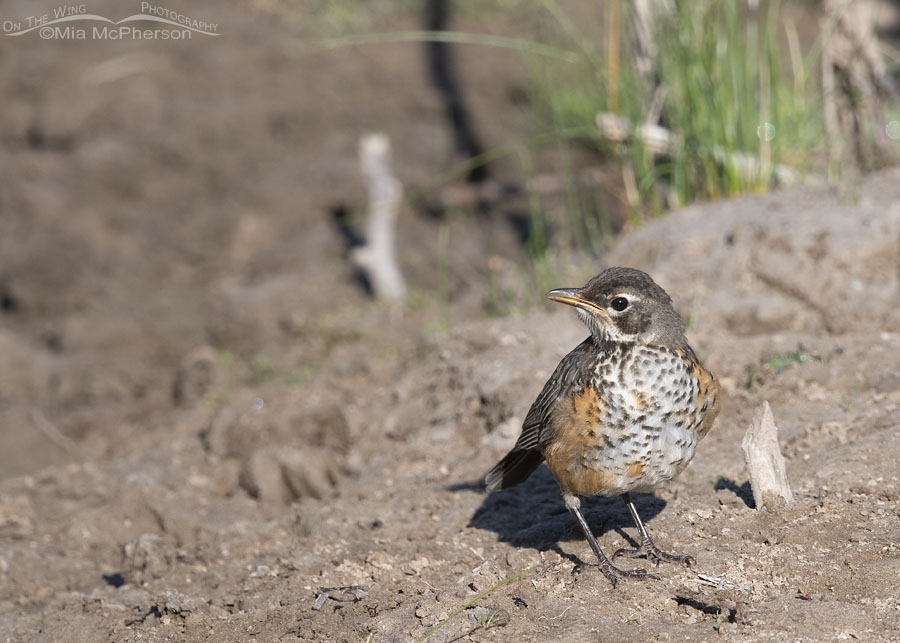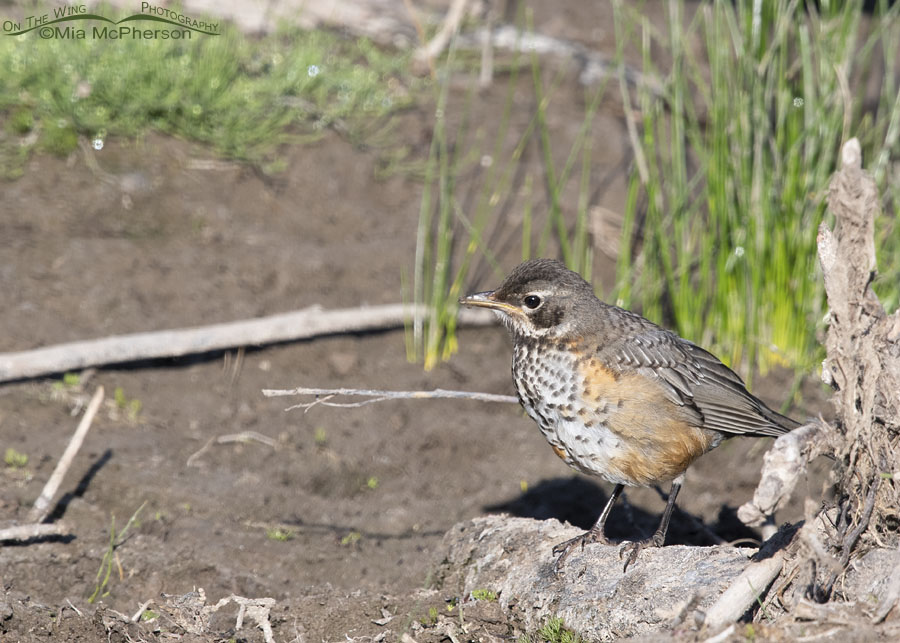 Fledgling American Robin on a dry creek bed – Nikon D500, f7.1, 1/1000, ISO 500, Nikkor 500mm VR with 1.4x TC, natural light
Fledgling American Robin on a dry creek bed – Nikon D500, f7.1, 1/1000, ISO 500, Nikkor 500mm VR with 1.4x TC, natural light
American Robins are abundant and can be found in woodlands, forests, urban and wilderness parks, mountains, tundra, backyards, fields, and gardens all over North America.
I know that some people consider American Robins a common bird and that there are bird photographers that will take a pass on photographing them. I don’t. A bird is worthy of photographing whether it is common or not in my mind.
 American Robin chick foraging on a dry creek bed – Nikon D500, f7.1, 1/1250, ISO 500, Nikkor 500mm VR with 1.4x TC, natural light
American Robin chick foraging on a dry creek bed – Nikon D500, f7.1, 1/1250, ISO 500, Nikkor 500mm VR with 1.4x TC, natural light
Three days ago I saw lots of young birds in the Wasatch Mountains east of where I live in Salt Lake City and among them were several American Robin fledglings.
I enjoyed watching the immature robins foraging on a dry creek bed where they walked and ran around searching for prey.
 Fledgling American Robin high in the Wasatch Mountains – Nikon D500, f7.1, 1/1250, ISO 500, Nikkor 500mm VR with 1.4x TC, natural light
Fledgling American Robin high in the Wasatch Mountains – Nikon D500, f7.1, 1/1250, ISO 500, Nikkor 500mm VR with 1.4x TC, natural light
The young robins appeared to be on their own. I don’t recall seeing any adults nearby and unlike the Gray Catbird chick I wrote about yesterday I never saw these robin chicks begging to be fed.
 Young American Robin checking out its world – Nikon D500, f7.1, 1/1000, ISO 500, Nikkor 500mm VR with 1.4x TC, natural light
Young American Robin checking out its world – Nikon D500, f7.1, 1/1000, ISO 500, Nikkor 500mm VR with 1.4x TC, natural light
The fledgling American Robins did seem to be exploring their mountain home while they searched for food. I saw one pick up a small wood chip that it kept in its bill for a few seconds before it let it drop to the ground and another one picking up dried grasses.
 American Robin fledgling looking for food – Nikon D500, f7.1, 1/1250, ISO 500, Nikkor 500mm VR with 1.4x TC, natural light
American Robin fledgling looking for food – Nikon D500, f7.1, 1/1250, ISO 500, Nikkor 500mm VR with 1.4x TC, natural light
Mostly though these young robins scurried around the dry creek bed where they stopped now and then to look around. I adore the spotted breasts of these young birds. They will lose the spots soon enough and will have the red breast that the adults have.
 Fledgling American Robin looking up at the sky – Nikon D500, f7.1, 1/1250, ISO 500, Nikkor 500mm VR with 1.4x TC, natural light
Fledgling American Robin looking up at the sky – Nikon D500, f7.1, 1/1250, ISO 500, Nikkor 500mm VR with 1.4x TC, natural light
American Robin chicks are the first wild birds I can remember seeing in a nest that was in an apple tree on the yard of one of my childhood homes. I always smile when I see them because I have such fond memories of the times I spent watching those chicks grow, fledge and make it on their own.
 Wasatch Mountain American Robin fledgling foraging – Nikon D500, f7.1, 1/1600, ISO 500, Nikkor 500mm VR with 1.4x TC, natural light
Wasatch Mountain American Robin fledgling foraging – Nikon D500, f7.1, 1/1600, ISO 500, Nikkor 500mm VR with 1.4x TC, natural light
The American Robin fledglings I photographed three days ago high in the Wasatch Mountains were fun to watch and photograph. I’m glad they showed up.
Life is good. Stay safe.
Mia
Click here to see more of my American Robin photos plus facts and information about this species.


Charming youngsters! So much fun to be able to see them exploring their world. I generally prefer “plentiful” over “common.”
Cool series of pics. Robins are such beautiful birds. Even as a little kid I always loved watching the Robins work over our garden and yard for worms and other sundries. Thanks Mia.
Thank you.
Fledglings (even the whingers) have a charm all of their own but I agree with you about ‘common’ birds. Their beauty is decidedly uncommon and worth celebrating.
Robin do seem to be on their own sooner than other fledglings. However I have seen adult robins ban together to help one in distress, and more than 2 parents will attempt to feed it.
Thank you so much for being able to see robins at this age. So precious. Not at all common for me!
The spots on the breast of the young always remind me that they are members of the thrush family. I saw one outside of my building two nights ago, same size as these. Sigh, although they are not waking me up at 3 a.m. they have stopped singing, and I miss that. Still hear their calls and scolding though.
Lovely images and I agree with you, that all birds are beautiful and are worthy of a photo, regardless if they are common or not. I look forward to seeing your daily posts and admire your dedication.
I’m glad they showed up too so you could photograph them for us!
Cute series